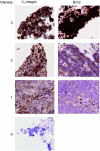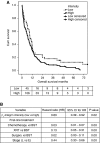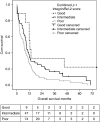Bcl-2 and β1-integrin predict survival in a tissue microarray of small cell lung cancer
- PMID: 21063403
- PMCID: PMC2994222
- DOI: 10.1038/sj.bjc.6605950
Bcl-2 and β1-integrin predict survival in a tissue microarray of small cell lung cancer
Abstract
Introduction: Survival in small cell lung cancer (SCLC) is limited by the development of chemoresistance. Factors associated with chemoresistance in vitro have been difficult to validate in vivo. Both Bcl-2 and β(1)-integrin have been identified as in vitro chemoresistance factors in SCLC but their importance in patients remains uncertain. Tissue microarrays (TMAs) are useful to validate biomarkers but no large TMA exists for SCLC. We designed an SCLC TMA to study potential biomarkers of prognosis and then used it to clarify the role of both Bcl-2 and β(1)-integrin in SCLC.
Methods: A TMA was constructed consisting of 184 cases of SCLC and stained for expression of Bcl-2 and β(1)-integrin. The slides were scored and the role of the proteins in survival was determined using Cox regression analysis. A meta-analysis of the role of Bcl-2 expression in SCLC prognosis was performed based on published results.
Results: Both proteins were expressed at high levels in the SCLC cases. For Bcl-2 (n=140), the hazard ratio for death if the staining was weak in intensity was 0.55 (0.33-0.94, P=0.03) and for β(1)-integrin (n=151) was 0.60 (0.39-0.92, P=0.02). The meta-analysis showed an overall hazard ratio for low expression of Bcl-2 of 0.91(0.74-1.09).
Conclusions: Both Bcl-2 and β(1)-integrin are independent prognostic factors in SCLC in this cohort although further validation is required to confirm their importance. A TMA of SCLC cases is feasible but challenging and an important tool for biomarker validation.
Figures





References
-
- Allred DC, Harvey JM, Berardo M, Clark GM (1998) Prognostic and predictive factors in breast cancer by immunohistochemical analysis. Mod Pathol 11: 155–168 - PubMed
-
- Amarasena IU, Walters JA, Wood-Baker R, Fong K (2008) Platinum versus non-platinum chemotherapy regimens for small cell lung cancer. Cochrane Database Syst Rev 2008; (4): CD006849 - PubMed
-
- Carney DN, Gazdar AF, Bepler G, Guccion JG, Marangos PJ, Moody TW, Zweig MH, Minna JD (1985) Establishment and identification of small cell lung cancer cell lines having classic and variant features. Cancer Res 45: 2913–2923 - PubMed
-
- Coghlin CL, Smith LJ, Bakar S, Stewart KN, Devereux GS, Nicolson MC, Kerr KM (2010) Quantitative analysis of tumor in bronchial biopsy specimens. J Thorac Oncol 5: 448–452 - PubMed
Publication types
MeSH terms
Substances
Grants and funding
LinkOut - more resources
Full Text Sources
Medical

